After an illustrious career in the Navy, Stephen Decatur died in his home on Lafayette Square following a duel with Commodore Barron.
-
November/December 2021
Volume66Issue7
Editor’s Note: Gil Klein is the author of Lafayette Square: Assassination, Protest & Murder at the White House. A former reporter for the Tampa Tribune and Media General New Service, he is now Resident Director of the University of Oklahoma’s Washington Journalism Program.
The recent protests in Lafayette Square were only the latest in a long list of events that brought mayhem and even murder to the president’s front door. The first tragedy happened just over 200 years ago when the naval hero Stephen Decatur died in his home, the first private house built on the Square, after a duel with a fellow naval officer.
For the young American nation, eager for heroes and seeking to assert its place among world powers, Stephen Decatur was legendary. Born on January 5, 1779, he grew up in Philadelphia. His father, Stephen Decatur, Sr. was a successful naval officer in the Revolution and in the early years of the American republic during the Quasi War with the French.
During Thomas Jefferson’s administration, the United States was at war with three of the Barbary States on north Africa – Algiers, Tripoli and Tunis. All three attacked American merchant shipping in the Mediterranean Sea, demanding ransom to release crews or tribute to allow safe passage. Jefferson, who opposed a large military, reluctantly sent warships to the Mediterranean to protect American shipping.
In 1803, one of the premier ships in the American fleet, the 36-gun frigate U.S.S. Philadelphia, ran aground off Tripoli and was captured. American Naval officers worried that if Philadelphia were repaired and rearmed, it could shift the balance of power in the Mediterranean in favor of the Barbary States.
At the age of 25, Decatur volunteered for what seemed like a suicide mission: sneak a small ship into the Tripoli harbor with a crew of 75 right under the guns of the city’s fort, overwhelm the Tripolitan crew aboard the much larger Philadelphia and set her ablaze. When asked how many men he would need to do the job, Decatur reportedly said “The fewer the men, the greater the glory.”
Disguising a recently captured ketch – a small two-masted ship – as a British merchant ship and hiding most of his crew below deck, Decatur sailed into the harbor as night fell and even convinced the Tripolitan sailors to allow him to tie up his ship against Philadelphia.
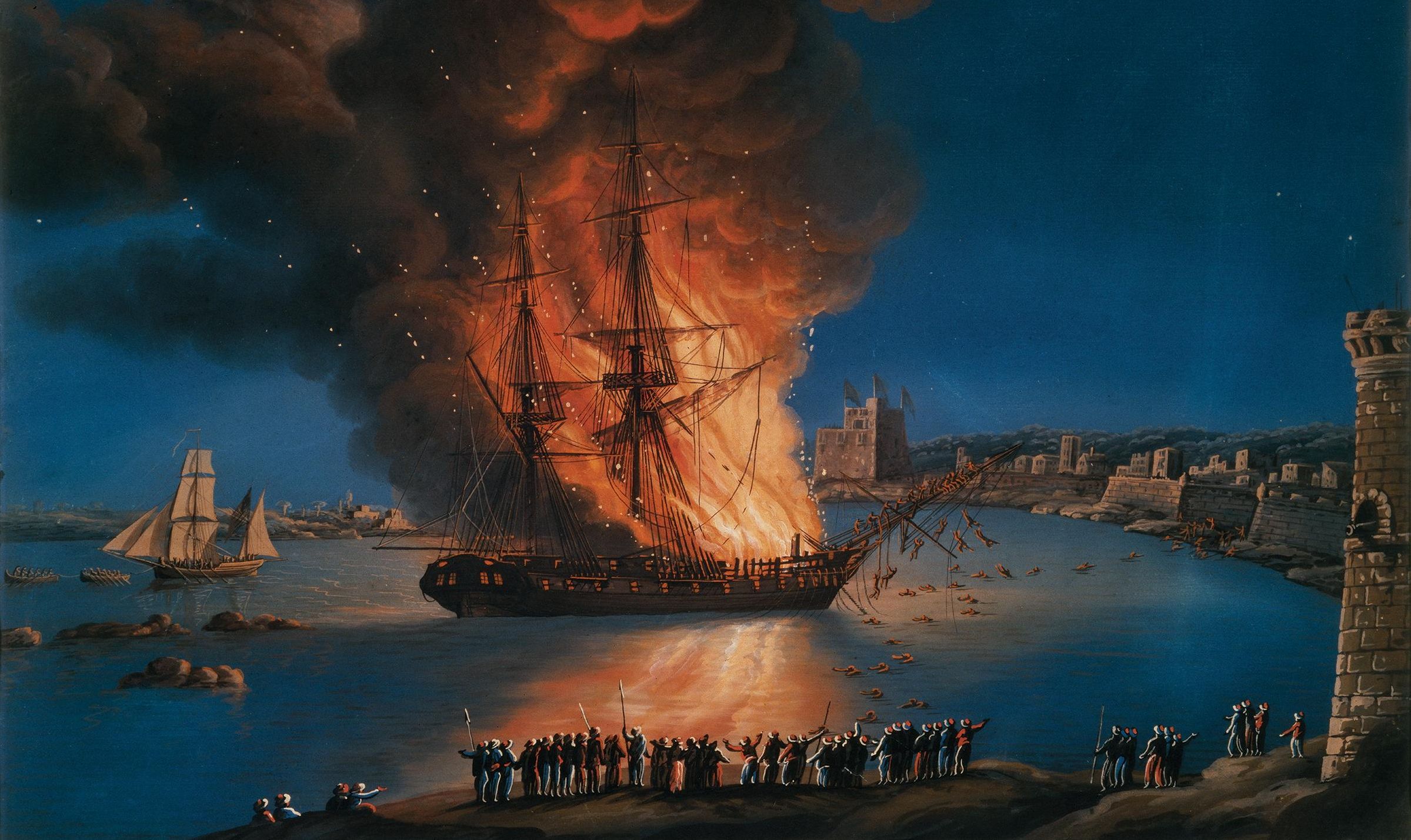
On Decatur’s signal, his crew rushed aboard Philadelphia, overwhelmed the crew and set the ship ablaze. Decatur was the last man off, jumping back onto the ketch just ahead of the flames. Batteries from the fort began firing at the escaping American ship, but it soon was out of range as the Americans gave three rousing cheers.
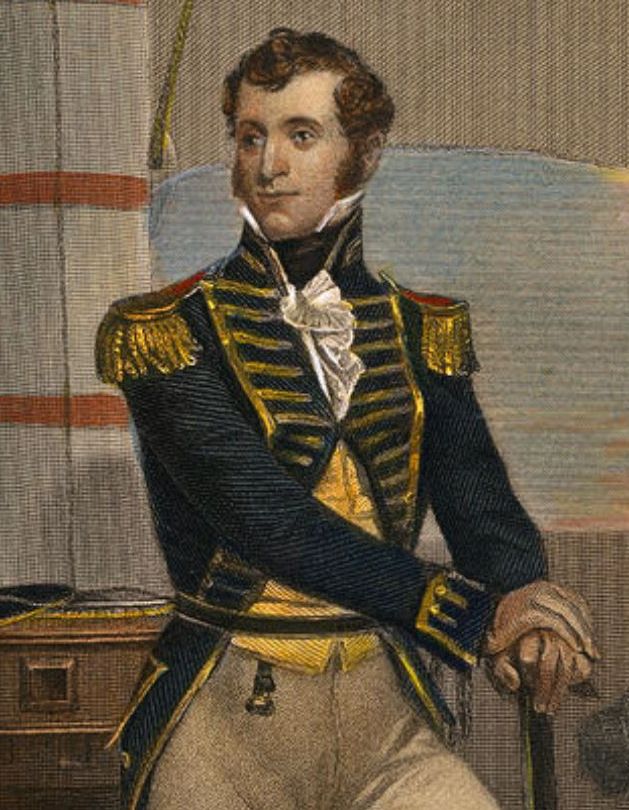
With just one seaman wounded in the fray and one enemy cannon ball piercing a sail, the raid was an overwhelming success. The British naval hero Admiral Horatio Nelson called it, “the most bold and daring act of the age.”
“Decatur’s destruction of the Philadelphia captured the imagination of the American public and set a standard of audacity and courage for generations of future naval officers,” wrote Spencer Tucker in his biography of Stephen Decatur. He was promoted to captain, making Decatur the youngest captain in American naval history.
But that was just the beginning of Decatur’s illustrious career. Later in 1804 he was back at Tripoli as a key officer in Edward Preble's fleet sent to force the pasha to honor international rules of navigation. Decatur was given command of a division of shallow-draft gunboats that led the attack into waters inside the harbor.
When Decatur got word that his brother James had been killed by the captain of a Tripolitan corsair, he caught up with the enemy ship and was the first American to jump aboard her in a boarding party outnumbered 5 to 1. Decatur sought out the captain and killed him in a furious fight.
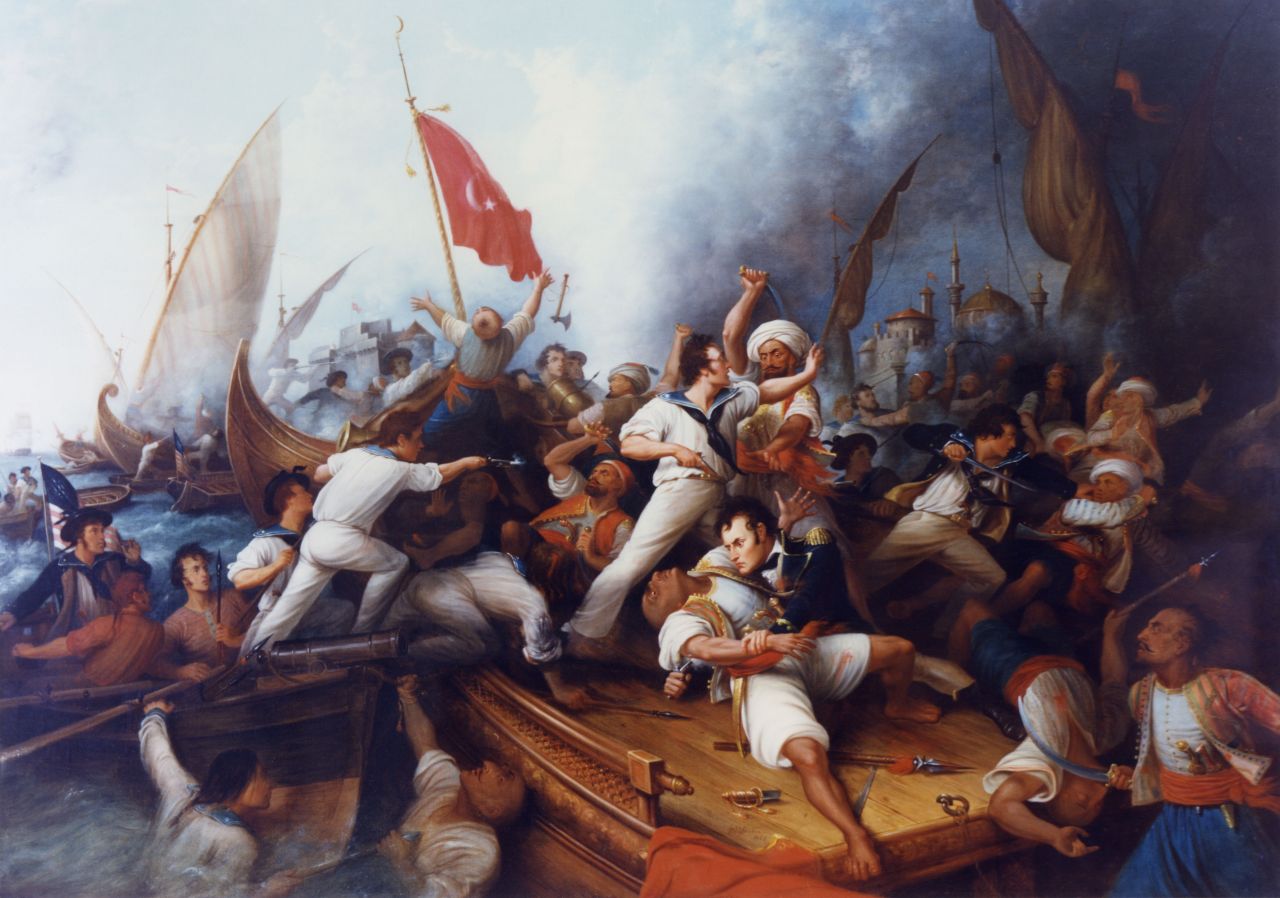
During the War of 1812, he was lionized for capturing the British frigate Macedonian, outfighting an officer who was considered one of the best frigate captains in the Royal Navy, John S. Carden. Ironically, Carden had dined with Decatur and his wife Susan when Macedonian was at Norfolk, and Carden bet Decatur a beaver hat that his vessel would take Decatur’s United States if the two should ever meet in battle.
After the war, Decatur commanded a fleet headed back to the Mediterranean Sea. The dey of Algiers had taken advantage of the American turmoil with Britain to capture American merchant ships with encouragement and supplies from the British. Within two weeks of ratification of the treaty ending the war, Congress authorized President Madison to take action against Algiers. Decatur led the first American fleet of ten ships, the largest ever to set sail. After capturing two Algerine warships and killing an admiral, the rest of the Algerine navy fled to neutral ports.
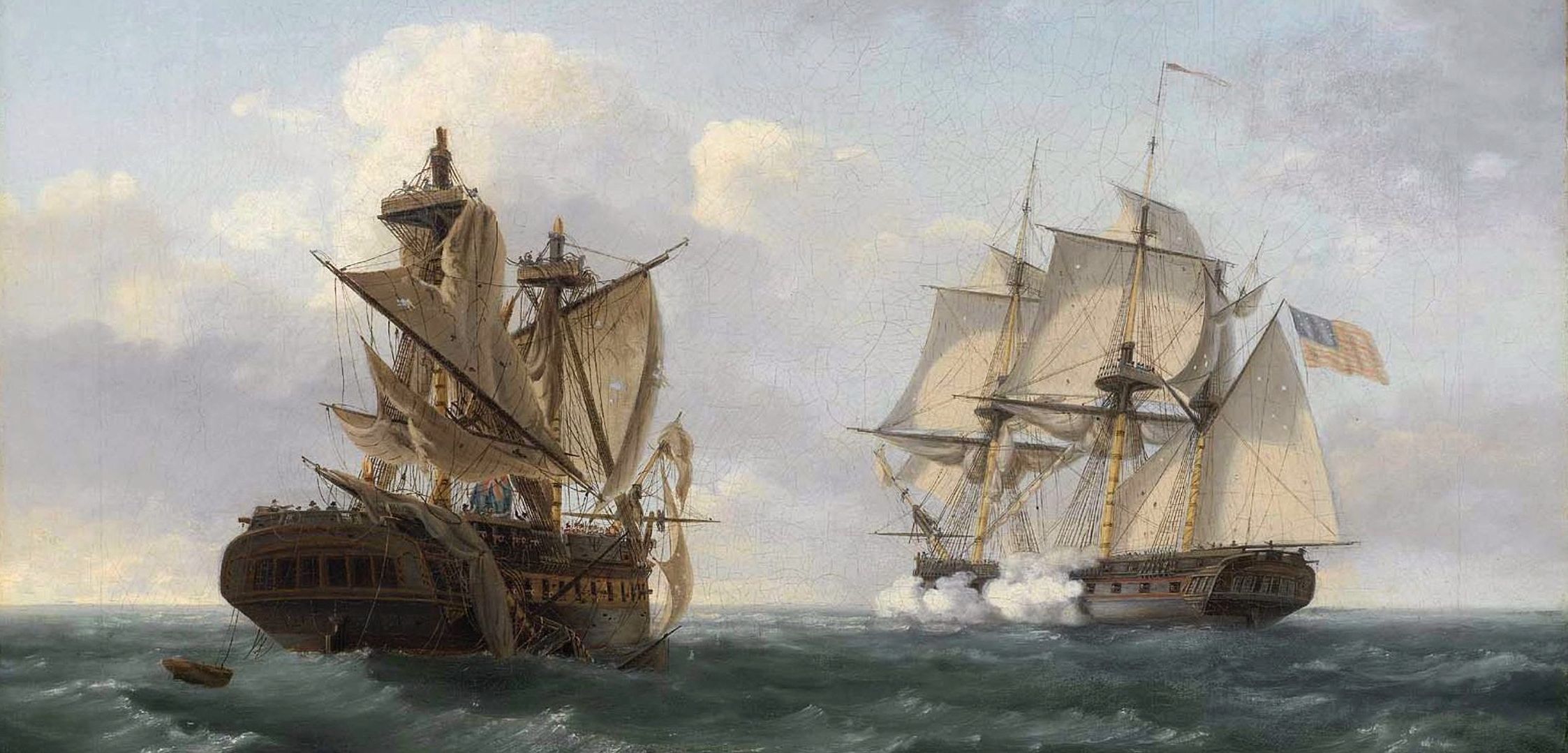
Decatur demanded that Algiers agree to a peace treaty on American terms. When it was signed, Decatur informed the American Secretary of the Navy Benjamin Crowninshield that since the treaty had been negotiated “at the mouth of the cannon,” enforcing it would require an American fleet in the Mediterranean. The Navy remains there to this day.
Just 71 days after sailing from New York, Decatur had defeated one of the Barbary States and convinced the other two to restore normal relations with the United States. American ships now could trade in the Mediterranean without fear of attack. Decatur’s ventures also made him a wealthy man. In those days, governments awarded victorious naval crews prize money for the ships they captured or sank, and the captain got the lion’s share.
Returning to the United States, Decatur was appointed as one of the commissioners to the Navy Board, a group of officers who advised the Secretary of the Navy, and he decided to settle down in Washington. He wanted to build a house worthy of a man of his stature and wealth and purchased a lot on Lafayette Park, which at the time was still called President’s Park and had no houses. Not until 1803 had President Jefferson decided that the park should be public and not part of the White House grounds, and it had been in a deplorable state through the War of 1812 when the White House was burned. With the rebuilding of the White House and construction of St. John’s Church on the other side of the park, the square began to become fashionable, and Decatur bought up several lots near it, as well as two on the northwest corner.
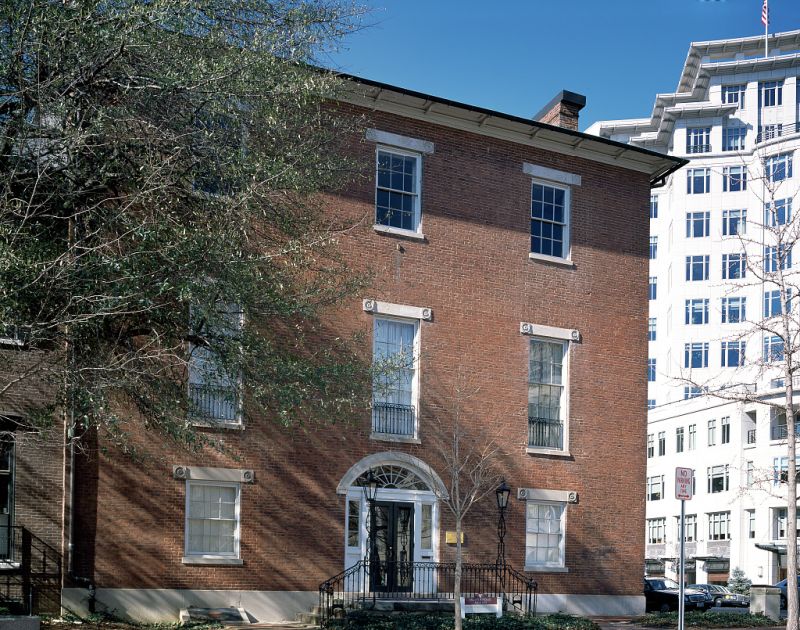
The house was designed and built in 1818 by Benjamin Henry Latrobe, America’s first prominent architect. He had worked on the White House and the Capitol, as well as St. John’s Church, before accepting the commission for Decatur’s house. It is a basic English design where family living spaces were on the first floor, but guests would be guided out of the vestibule and up the grand staircase for formal entertainment in the ballroom and large dining room.
The house is the only one on Lafayette Square still open to the public, and is owned by the National Trust for Historic Preservation and operated by the White House Historical Society. The vestibule just inside the front door is painted just as it was in Decatur’s day: light blue walls, chrome yellow baseboards and white doors. If Decatur walked in now, he would recognize it immediately as the day he entered with his wife, Susan, to maintain a life of parties and power.
Now the story of the American hero begins to turn dark. Decatur’s rapid rise and national fame piqued jealousy among some of the other naval officers who believed their contributions had been overlooked. Among those most angry was Commodore James Barron, who had one time been Decatur’s superior when as a new lieutenant, Decatur sailed on his first mission to the Mediterranean on the U.S.S. New York under Barron’s command. Now Barron’s career languished, and he blamed Decatur.
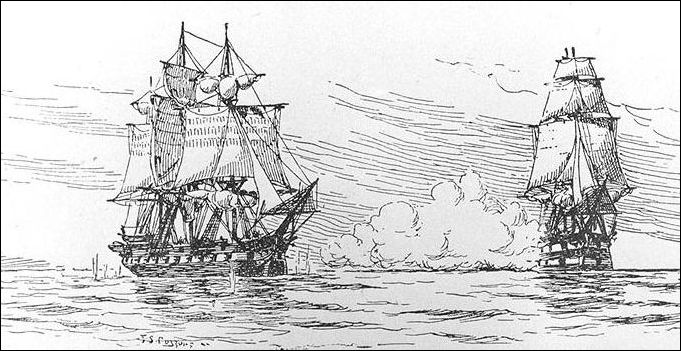
In 1807, Barron had commanded the U.S.S. Chesapeake. At that time, the British were in a desperate war with France under Napoleon. British seamen often deserted to take berths with American naval and merchant vessels where conditions were much less severe. British warships often stopped American ships to take back seamen they claimed were British subjects. Controversy over these seizures roiled British-American relations and eventually contributed to the War of 1812.
But that was still five years off when the Chesapeake sailed out of Norfolk bound for the Mediterranean in 1807. A larger British ship, the Leopard, stopped the Chesapeake not far off the American coast. Barron was so certain this was a peaceful encounter that he didn’t order his ship prepared for action. When the British demanded to be allowed to search the Chesapeake for deserters, Barron refused. Only then did he see that the British were not going to act peacefully, but by then, it was too late.
The Leopard fired three broadsides into the Chesapeake, and Barron had no alternative but to surrender. The British took the sailors they wanted and left Barron to sail his badly damaged ship back to Norfolk. Three of his men had been killed in the action and 18 injured, one critically. Barron himself had been wounded.
In the aftermath, American public opinion demanded war with Britain, but President Jefferson demurred. Barron was relieved of his command. Decatur was promoted to commodore and put in command of the Chesapeake and the gunboats in Norfolk harbor as he rapidly ordered repairs and training of the crew in preparation for war. Decatur served as judge on Barron’s court martial that found the captain guilty of neglecting to clear his ship for action in the face of probable action against the Leopard. Barron was suspended from the Navy without pay for five years beginning Feb. 8, 1808.
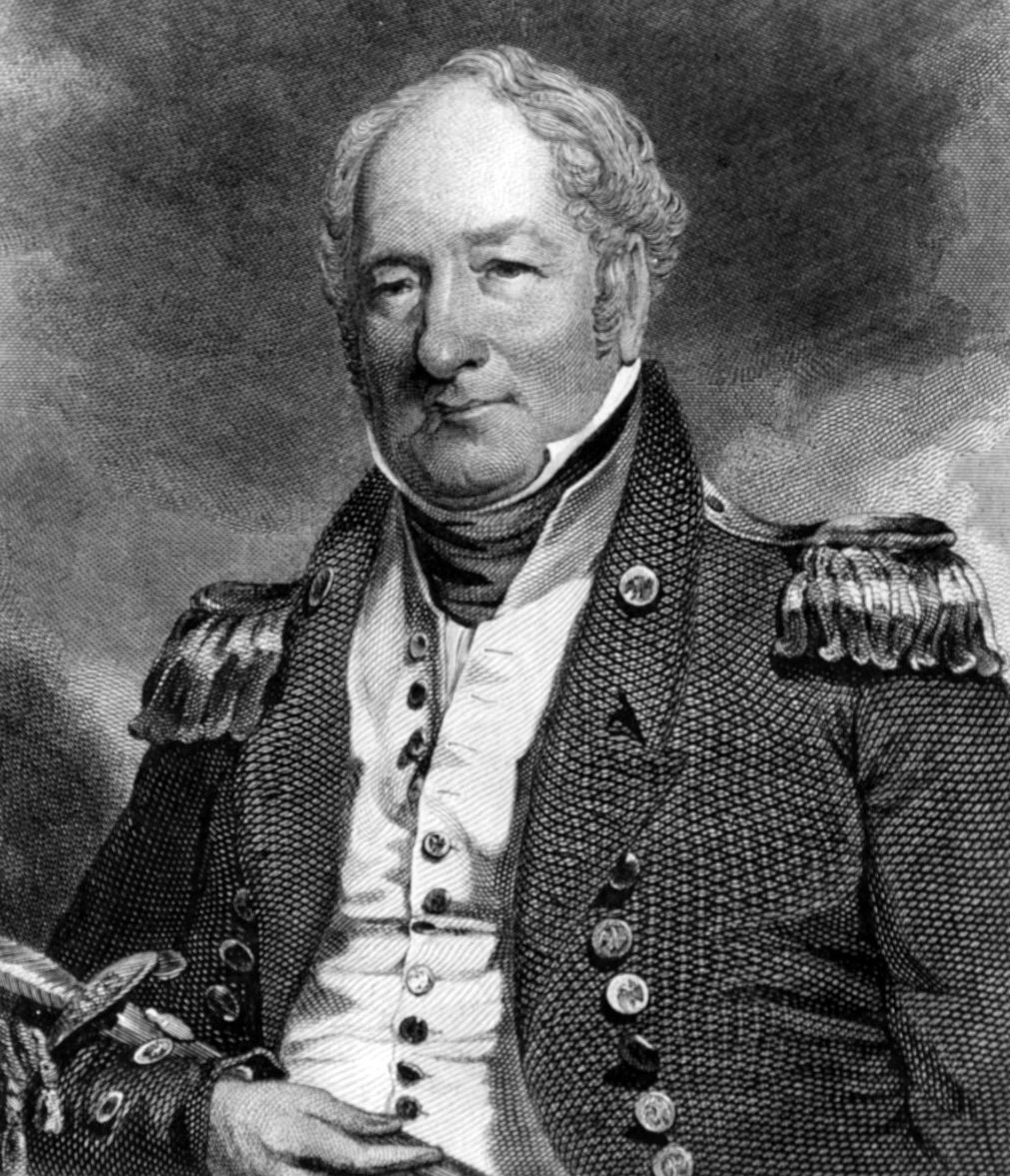
Baron’s suspension ended during the War of 1812, when the young nation needed experienced officers. By that time, he was in Sweden and claimed he couldn’t return to the United States when he was called back to service. He said he could not raise the money for passage, and the war ended before he returned. But when he did, he asked for a commission in the peacetime Navy. Decatur, in his role on the Navy board, turned him down. With the Navy downsizing, why give a command to an officer who did not rally to the colors during wartime?
Egged on by fellow officers who may not have had their best interests at heart, Decatur and Barron exchanged a series of heated letters. Decatur told Barron he would not challenge him to a duel, and said that if he wanted a fight, Barron would have to make the challenge. On Jan. 16, 1820 he did. “The whole tenor of your conduct to me justifies this course of proceeding on my part,” he wrote. Decatur agreed to a duel.
In the first half of the 19th century, dueling was still an accepted practice between men, despite efforts of law enforcement and clergy to condemn it. Gentlemen believed they had to uphold their honor at any cost, and any slight would be countered by a challenge. The vice president of the United States, Aaron Burr, had famously challenged former Treasury Secretary Alexander Hamilton, Andrew Jackson fought duels before he was president, and Secretary of State Henry Clay later challenged Rep. John Randolph to a duel after the congressman accused him on the House floor of “crucifying the Constitution and cheating at cards.”
The Navy had the reputation as a hotbed of dueling, although naval historian Christopher McKee insisted it was overstated. Only 18 naval officers had been killed by dueling before 1815, he pointed out, a mere 1 percent of all of the naval officers who left the service before that date. It usually was confined to the younger officers, who were still in their late teens or early 20s. If either the challenger or the one challenged refused to fight, he would be labeled a coward and suffer stigmatization, if not social ostracism.
As a young officer, Decatur had participated in a duel as a second, the person who acted for one of the duelers in arranging the fight. While dueling was condemned in the Navy, it had not stopped because it wasn’t explicitly forbidden by the Navy’s basic disciplinary code.
On the morning of March 22, 1820, Decatur and his second, Captain William Bainbridge, as well as a friend Samuel Hambleton, headed out in a carriage toward the Maryland border. Since dueling was illegal in the District of Columbia, an area near Bladensburg just over the border had become a favorite dueling ground. Decatur had told his wife nothing of the impending duel, but had quietly arranged for some of her relatives and friends to be visiting her in case moral support was needed.
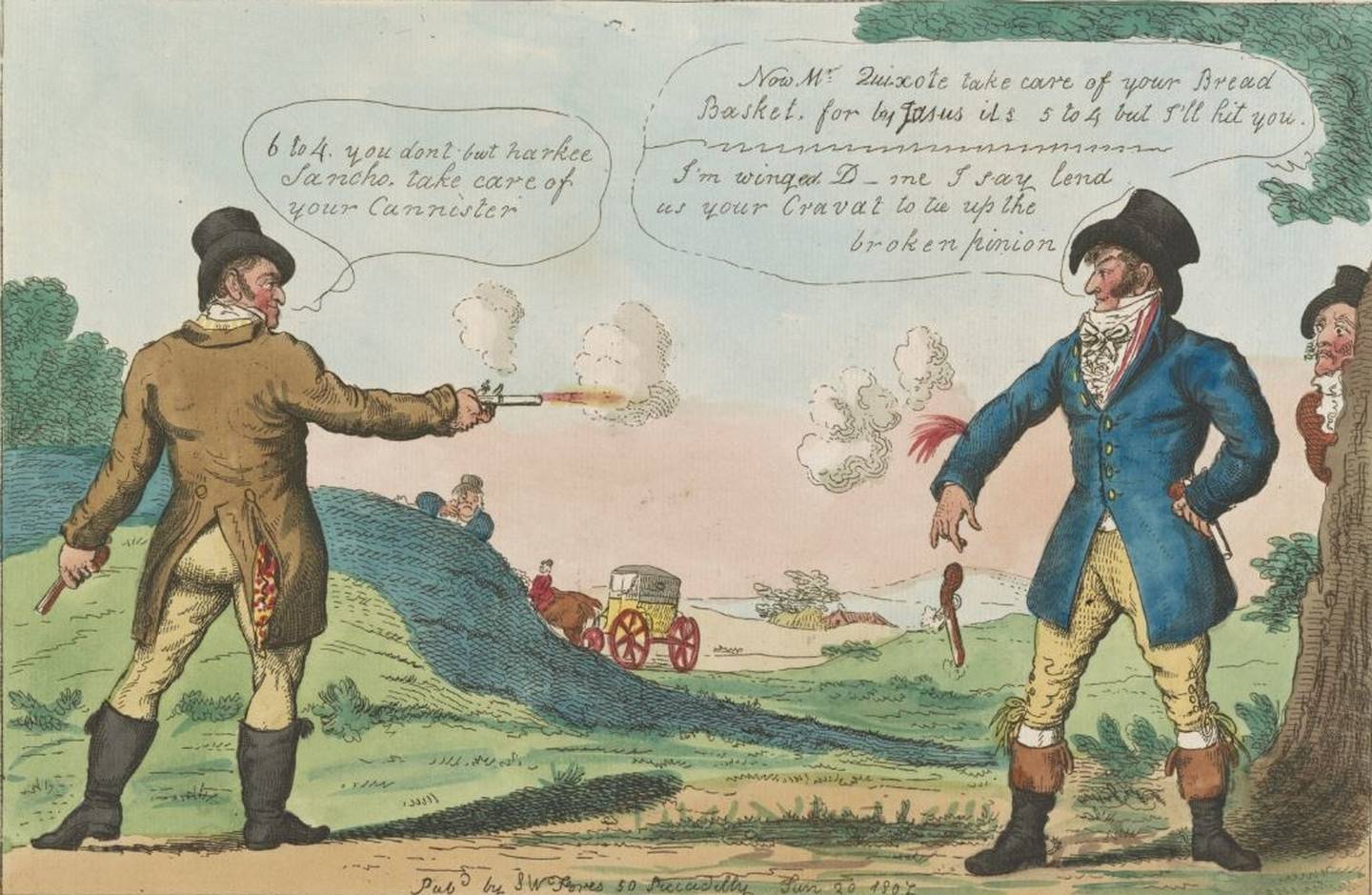
The duel was set for 9:00 a.m. Barron met Decatur at the dueling ground with his second, Capt. Jesse Elliott. The two seconds had met days earlier and agreed to the ground rules, pistols at eight paces, a close and deadly distance for dueling. Some historians say there is evidence that even though Decatur had chosen him as his second, Bainbridge was secretly fomenting the dispute because he was jealous of Decatur. With the pistols loaded, Bainbridge measured out the eight paces, as the two duelers faced each other Barron told Decatur that if they met in the next world, he hoped they would be better friends. Decatur replied, “I have never been your enemy, Sir.”
The two duelers fired simultaneously both aiming at the other’s hip to disable but not kill. Both shots hit home, but the one striking Decatur did far more damage than the one striking Barron. Everyone there knew it was fatal. “I am mortally wounded, at least I believe so, and I wish I had fallen in defense of my country,” Decatur said.
Lying next to Barron for a while before he was lifted into his carriage, Barron, believing he too would die, said the duel had been conducted honorably and he forgave Decatur from the bottom of his heart. Decatur said he had opposed Barron’s reinstatement because he had not returned during the war. He asked him why. “Because I had not the means.” Bainbridge told the story differently. He said Barron replied, “I will tell you what I had not expected to tell a living soul. I was in an English prison for debt.”
Rushed back to the house in Washington, Decatur insisted that his wife and two nieces go upstairs before he was brought in. He was carried through the front door, past the still nearly new light blue walls with the chrome yellow baseboards, and through a door to the left into the parlor. He finally relented and allowed Susan to come see him. No furniture is the room now, but one can imagine, while standing there, the death scene that lasted to 10:00 that night.
Decatur was universally admired at the time of his death. How popular? Decatur biographer Robert Allison’s description of the naval hero’s funeral gives a good account of what happened from the time word of the duel circulated in Washington until his funeral.
Business in Washington ceased. In the House of Representatives, the speaker could hardly keep the members in order “so anxious do they seem to ascertain the particulars and so generally was Commodore Decatur beloved by the members.’’ President Monroe cancelled his afternoon receptions. From the moment Decatur fell, nothing else was thought of.
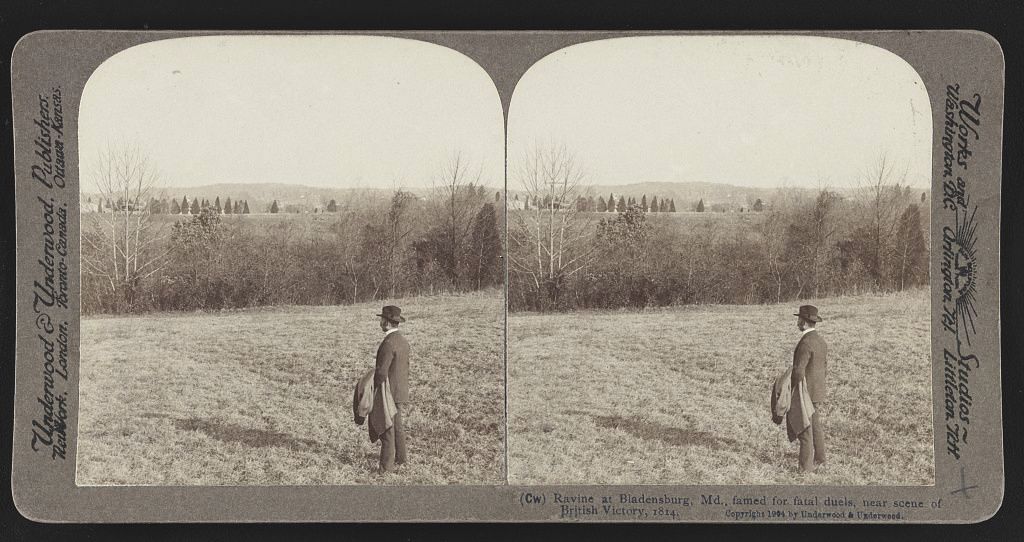
On the day of the funeral, thousands of mourners – most of the population of Washington, Georgetown and Alexandria – thronged to the Decatur House. When it was time to start the procession, the house was so packed movement was impossible. The funeral director came to the door, telling all who were not either members of Congress or officers in the military to back away. A sailor told him, “I tell you what, mister. There’s other people besides officers and members of Congress that respect Commodore Decatur, and I say by G--, they shall go in.”
The director gave up his order of march and reversed it: the citizens would lead and the dignitaries would follow. All of official Washington was there, including President Monroe, Chief Justice John Marshall, and most of the House and Senate since both chambers had adjourned for the day in Decatur’s honor. “Since the foundations of this city were laid, no such assemblage of citizens and strangers, on such an occasion has been seen,” one newspaper account said.
The procession’s pace was set by a dirge from the Marine Band and the guns fired at intervals of one minute at the Navy yard, their sound growing more distant as the thousands of citizens walked from President’s Square to the Joel Barlow estate, Kalorama, on Rock Creek where Decatur’s body was laid to rest.
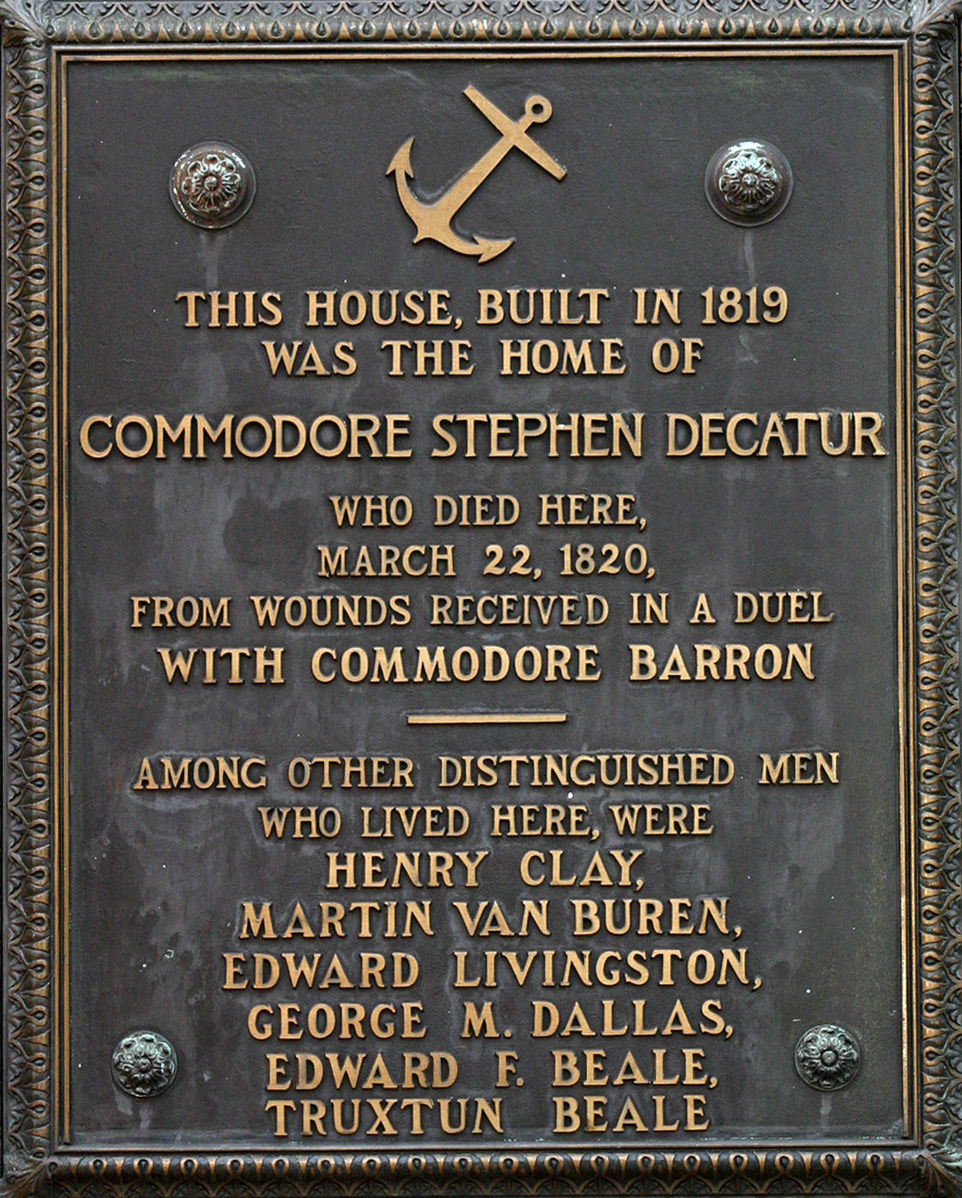
As an odd footnote to the account, Matthew Costello, an history researcher at the Decatur House, came across an account that appeared in the December 23, 1883 Chicago Tribune. It is the story told by a woman who as a young girl often visited the house after the commodore’s death. She said Susan had put the bloodstained clothes into a glass globe about two feet in diameter where they could be seen but never touched. “They were the clothes worn by Decatur when they brought him home done to death by the red-handed Barron, and they were drenched in places with her blood. Mrs. Decatur never allowed them to be touched. She gave up that society in which she had been a queen, and became devoté, and many an hour she spent on her knees before this globe praying for the soul untimely sped and (sublime effort of religion!) for him whose hand had driven it forth into eternity.”
Could that be true? No such globe has ever been found, and the belongings of the Decatur family were dispersed long ago when Susan had to leave the house. To try to make ends meet, she rented it to high-ranking government officials, including three successive secretaries of state – Henry Clay, Martin Van Buren and Edward Livingston.
Ironically, Clay departed from the house on April 8, 1826 to fight a duel with Virginia Sen. John Randolph just across the Potomac River in north Arlington. Randolph had insulted Clay on the floor of the Senate, and the secretary challenged him. Both came back unscathed, although Clay’s bullet creased Randolph’s coat.
Decatur's home is now the headquarters of the White House Historical Association, and arrangements can be made for a tour that includes the room where Decatur died.

